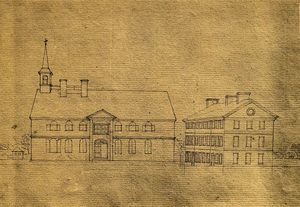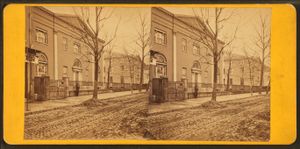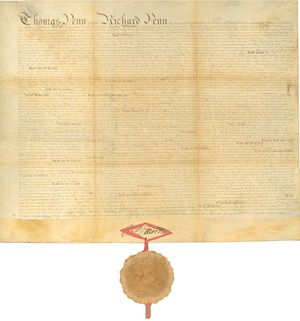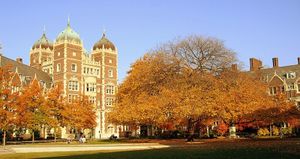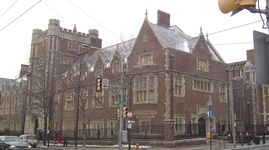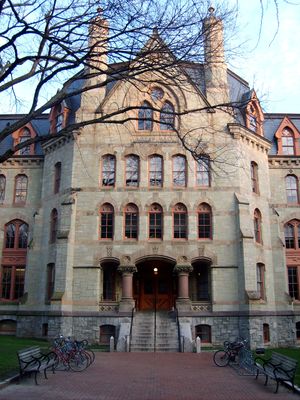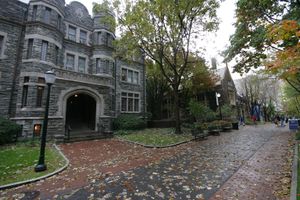جامعة پنسلڤانيا
University of Pennsylvania | |
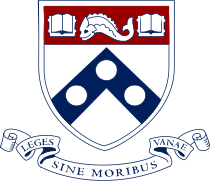 | |
| لاتينية: Universitas Pennsylvaniensis | |
| الشعار | Leges sine moribus vanae (Latin) |
|---|---|
الشعار بالإنجليزية | القوانين بدون أخلاق بلا جدوى |
| النوع | جامعة بحثية خصاة |
| تأسست | 14 نوفمبر 1740 [note 1] |
| المؤسس | بنجامن فرانكلن |
| الوقف | $14.7 billion (2019)[4] |
| الميزانية | $10.2 billion[5] (2019) |
| الرئيس | إيمي گوتمان |
| Provost | وندل پرتشت |
| رئيس مجلس الأمناء | ديڤد ل. كوهن[6] |
| الطاقم الأكاديمي | 4,793 (2018)[7] |
| الطلبة | 21,960 (2018)[7] |
| طلبة قبل البكالوريوس | 10,605 (2018)[7] |
| طلاب الدراسات العليا | 11,355 (2018)[7] |
| الموقع | ، ، الولايات المتحدة |
| الحرم | الحضري، 1,085 acres (4.39 km2) الإجمالي: 299 acres (1.21 km2)، حرم المدينة الجامعية؛ 694 acres (2.81 km2), New Bolton Center؛ 92 acres (0.37 km2), Morris Arboretum |
| ألوان المدرسة | Red and Blue[8] |
| الكنية | Quakers |
| الانتساب | AAU COFHE NAICU 568 Group URA |
| الموقع الإلكتروني | upenn |
 | |
جامعة پنسلڤانيا (University of Pennsylvania ؛ پن Penn أو يوپن UPenn) هي جامعة بحثية خاصة ضمن رابطة اللبلاب وتقع في فيلادلفيا، پنسلڤانيا. وهي واحدة من الكليات الاستعمارية التسع التي تأسست قبل إعلان الاستقلال وأول مؤسسة تعليم عالي في الولايات المتحدة تشير لنفسها كجامعة.[9] بنجامن فرانكلن، مؤسس پن وأول رؤسائها، دعا إلى برنامج تعليمي يدرب القادة في التجارة والحكم والخدمة العامة، بما يشبه منهج معاصر للفنون الليبرالية.[10]
تضم الجامعة أربع مدارس لدراسة البكالوريوس وكذلك اثني عشر مدرسة للدراسات العليا والمهنية. وبين مدارس الدراسات العليا والمهنية توجد أول مدرسة طب في أمريكا الشمالية (Perelman School of Medicine، 1765), the first collegiate business school (مدرسة وارتون، 1881) and the first "student union" building and organization (Houston Hall، 1896).[11] In 2018, the university had an endowment of $13.8 billion, the seventh largest endowment of all colleges in the United States,[12] as well as an academic research budget of $966 million.[7]
وفي الأنشطة الرياضية، Quakers field varsity teams in 33 sports as a member of the NCAA Division I Ivy League conference and hold a total of 210 Ivy League championships as of 2017.[13]
وفي 2018، distinguished alumni include 14 heads of state, 64 billionaire alumni;[14] 3 United States Supreme Court justices; 33 United States Senators، 44 United States Governors and 159 members of the U.S. House of Representatives؛ 8 signers of the United States Declaration of Independence؛ 12 signers of the United States Constitution، 24 members of the Continental Congress، والرئيس الحالي، دونالد ترمپ.[15][16][17] Other notable alumni include 27 Rhodes Scholars,[18] 15 Marshall Scholarship recipients,[19] 16 Pulitzer Prize winners, and 48 Fulbright Scholars.[20] As of October 2019, 36 Nobel laureates، 169 Guggenheim Fellows، 80 members of the American Academy of Arts and Sciences، and many Fortune 500 CEOs have been affiliated with the university.[21][22][23]
. . . . . . . . . . . . . . . . . . . . . . . . . . . . . . . . . . . . . . . . . . . . . . . . . . . . . . . . . . . . . . . . . . . . . . . . . . . . . . . . . . . . . . . . . . . . . . . . . . . . . . . . . . . . . . . . . . . . . . . . . . . . . . . . . . . . . . . . . . . . . . . . . . . . . . . . . . . . . . . . . . . . . . . .
التاريخ
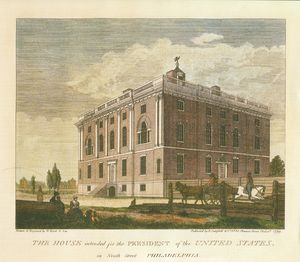
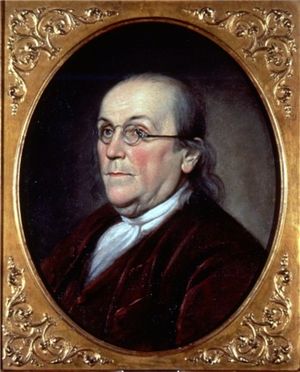
تعتبـِر جامعة پنسلڤانيا نفسها رابع أقدم مؤسسة تعليم عالي في الولايات المتحدة، بالرغم من أنه ينافسها في الزعم جامعتا پرنستون وكلومبيا.{{refn|group=note| پن هي رابع أقدم مؤسسة تعليمية باستخدام تاريخ التأسيس المزعوم من كل مؤسسة. The College of Philadelphia (later Penn), كلية نيوجرزي (لاحقاً جامعة پرنستون) و King's College (later Columbia College, now Columbia University) all originated within a few years of each other. After initially designating 1750 as its founding date, Penn later considered 1749 to be its founding date for more than a century, including alumni observing a centennial celebration in 1849. In 1895, several elite universities in the United States convened in New York City as the "Intercollegiate Commission" at the invitation of جون ج. مكوك، الضابط في جيش الاتحاد أثناء الحرب الأهلية الأمريكية وعضو مجلس أمناء پرنستون الذي ترأس لجنتها on Academic Dress. The primary purpose of the conference was to standardize American academic regalia, which was accomplished through the adoption of the Intercollegiate Code on Academic Costume. This formalized protocol included a provision that henceforth academic processions would place visiting dignitaries and other officials in the order of their institution's founding dates. The following year, Penn's The Alumni Register magazine, published by the General Alumni Society, began a campaign to retroactively revise the University's founding date to 1740, in order to become older than Princeton, which had been chartered in 1746. Three years later in 1899, Penn's board of trustees acceded to this alumni initiative and officially changed its founding date from 1749 to 1740, affecting its rank in academic processions as well as the informal bragging rights that come with the age-based hierarchy in academia generally. See "Building Penn's Brand" for more details on why Penn did this.[24] Princeton implicitly challenges this rationale,[25] also considering itself to be the nation's fourth oldest institution of higher learning.[26] To further complicate the comparison, a University of Edinburgh-educated Presbyterian minister from Scotland, named William Tennent and his son Gilbert Tennent operated a "Log College" in Bucks County, Pennsylvania، from 1726 until 1746; some have suggested a connection between it and Princeton because five members of Princeton's first Board of Trustees were affiliated with the "Log College", including Gilbert Tennent, William Tennent, Jr., and Samuel Finley, the latter of whom later became President of Princeton. All twelve members of Princeton's first Board of Trustees were leaders from the "New Side" or "New Light" wing of the Presbyterian Church in the New Jersey، New York and Pennsylvania areas.[27] This antecedent relationship, if considered a formal lineage with institutional continuity, would justify pushing Princeton's founding date back to 1726, earlier than Penn's 1740. However, Princeton has not done so, and a Princeton historian says that "the facts do not warrant" such an interpretation.[28] Columbia also implicitly challenges Penn's use of either 1750, 1749 or 1740, as it claims to be the fifth oldest institution of higher learning in the United States (after Harvard, William & Mary, Yale and Princeton), based upon its charter date of 1754 and Penn's charter date of 1755.[29] Academic histories of American higher education generally list Penn as fifth or sixth, after Princeton and immediately before or after that of Columbia.[30][31][32]
Even Penn's own account of its early history agrees that the original secondary school (the Academy of Philadelphia) did not add an institution of higher learning (the College of Philadelphia) until 1755, but university officials continue to make it their practice to assert their fourth-oldest place in academic processions. Other American universities which began as a colonial-era, early version of secondary schools such as St. John's College (founded as "King William's School" in 1696) and the University of Delaware (founded as "the Free Academy" in 1743) choose to march based upon the date they became institutions of higher learning. Penn History Professor Edgar Potts Cheyney was a member of the Penn class of 1883 who played a leading role in the 1896-1899 alumni campaign to change the university's formal founding date.
أكاديمياً
المركز الطبي الأكاديمي ومجمع الأبحاث الطبية الحيوية
Penn's health-related programs—including the Schools of Medicine, Dental Medicine, Nursing, and Veterinary Medicine, and programs in bioengineering (School of Engineering), biology (School of Arts and Sciences), and health management (the Wharton School)—are among the university's strongest academic components.
انتقائية القبول
The Princeton Review ranks Penn as the 6th most selective school in the United States.[33] For the Class of 2023, entering in the fall of 2019,[34] the University received a record-high 44,960 applications and admitted 7.44 percent of the applicants (5.46% in the regular decision cycle), marking Penn's most selective admissions cycle in the history of the University.[35] The Atlantic also ranked Penn among the 10 most selective schools in the country. At the graduate level, based on admission statistics from U.S. News & World Report, Penn's most selective programs include its law school, the health care schools (medicine, dental medicine, nursing, Social Work and veterinary) and its business school.
البحث والإبداع والاكتشاف
الترتيب
|
|
| ||||||||||||||||||||||||||||||||||||||||||||||||||||||||||||||||||||||||||||||||||||||||||||||||||||||||||||||||||||||||||||||||
- الترتيب العام
According to U.S. News & World Report's 2020 rankings, Penn is ranked 6th among national universities in the United States.[46] U.S. News also includes Penn in its Most Popular National Universities list[47] and so does The Princeton Review in its Dream Colleges list.[48] As reported by USA Today, Penn was ranked 1st in the United States by College Factual for 2015.[49]
- الترتيب في الأبحاث
The Center for Measuring University Performance places Penn in the first tier of the United States' top research universities (tied with Columbia، MIT and Stanford), based on research expenditures, faculty awards, PhD granted and other academic criteria.[50] Penn was also ranked 18th of all U.S. colleges and universities in terms of R&D expenditures in fiscal year 2013 by the National Science Foundation.[51] The High Impact Universities research performance index ranks Penn 8th in the world, whereas the 2010 Performance Ranking of Scientific Papers for World Universities (published by the Higher Education Evaluation and Accreditation Council of Taiwan) ranks Penn 11th in the world for 2007,[52] 2008 [53] and 2010 [54] and 9th for 2009.[55]
The Performance Ranking of Scientific Papers measures universities' research productivity, research impact, and research excellence based on the scientific papers published by their academic staff. The SCImago Institutions Rankings World Report 2012, which ranks world universities, national institutions and academies in terms of research output, ranks Penn 7th nationally among U.S. universities (2nd in the Ivy League behind Harvard) and 28th in the world overall (the first being France's Centre National de la Recherche Scientifique).[56]
- ترتيبات أخرى
The Mines ParisTech International Professional Ranking، which ranks universities on the basis of the number of alumni listed among CEOs in the 500 largest worldwide companies, ranks Penn 11th worldwide and 2nd nationally behind Harvard.[57] According to a US News article in 2010, Penn is tied for second (tied with Dartmouth College and Tufts University) for the number of undergraduate alumni who are current Fortune 100 CEOs.[58] Forbes ranked Penn 17th, based on a variety of criteria.[59]
- برامج الدراسات العليا والمهنية
Among its professional schools, the schools of business، communication، dentistry، medicine، nursing، and veterinary medicine rank in the top 5 nationally [60] Penn's Law School is ranked 7th, its Design school is 8th, and its School of Education and School of Social Policy and Practice are ranked in the top 10 [60] In the 2010 QS Global 200 Business Schools Report، Penn was ranked 2nd in North America.[61]
- راتب التنفيذي الأول
Amy Gutmann's total compensation in 2018 was $3.9 million, placing her as the third-highest paid college president in the nation and second in the Ivy League.[62]
حياة الطلبة
| Ethnic enrollment, Fall 2018[63] |
Under- graduates |
|---|---|
| African American | 715 (7.1%) |
| Native American | 12 (0.1%) |
| Asian American and Pacific Islander |
2,084 (20.7%) |
| Hispanic and Latino American |
1,044 (10.4%) |
| White | 4,278 (42.6%) |
| International | 1,261 (12.6%) |
| Two or more races, non-Hispanic | 460 (4.6%) |
| Unknown | 179 (1.8%) |
| Total | 10,033 (100%) |
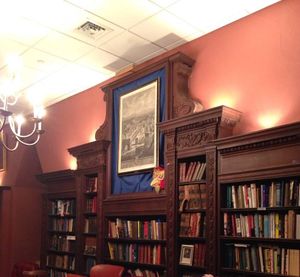
. . . . . . . . . . . . . . . . . . . . . . . . . . . . . . . . . . . . . . . . . . . . . . . . . . . . . . . . . . . . . . . . . . . . . . . . . . . . . . . . . . . . . . . . . . . . . . . . . . . . . . . . . . . . . . . . . . . . . . . . . . . . . . . . . . . . . . . . . . . . . . . . . . . . . . . . . . . . . . . . . . . . . . . .
الديمغرافيا
Of those accepted for admission to the undergraduate Class of 2018, 52 percent are Asian، Hispanic، African-American or Native American.[7] In addition, 53% of current students are women.[7]
انظر أيضاً
- List of universities by number of billionaire alumni
- التعليم في فيلادلفيا
- Think Tanks and Civil Societies Program (TTCSP)
- University of Pennsylvania Press
ملاحظات
- ^ تستخدم الجامعة رسمياً 1740 كتاريخ التأسيس وذلك منذ 1899. The ideas and intellectual inspiration for the academic institution stem from 1749, with a pamphlet published by Benjamin Franklin، (1705/1706–1790). When Franklin's institution was established, it inhabited a schoolhouse built on November 14, 1740 for another school, which never came to practical fruition.[1] Penn archivist Mark Frazier Lloyd notes: "In 1899, UPenn's Trustees adopted a resolution that established 1740 as the founding date, but good cases may be made for 1749, when Franklin first convened the Trustees, or 1751, when the first classes were taught at the affiliated secondary school for boys, Academy of Philadelphia, or 1755, when Penn obtained its collegiate charter to add a post-secondary institution, the College of Philadelphia."[2] Princeton's library presents another, diplomatically phrased view.[3]
المراجع
- ^ "Penn History Exhibits - University Archives and Records Center". archives.upenn.edu.
- ^ "A Penn Trivial Pursuit - Penn Current". web.archive.org. June 3, 2011. Archived from the original on 2011-06-03.
- ^ "Seeley G. Mudd Library : FAQ Princeton vs. University of Pennsylvania: Which is the Older Institution?". web.archive.org. March 19, 2003. Archived from the original on 2003-03-19.
- ^ As of June 30, 2019. "Penn's Endowment Returns 6.5% in a Slowdown From Last Year". Bloomberg.com. 2019. Retrieved September 26, 2019.
- ^ "Operating Budget". University of Pennsylvania Office of Budget and Management Analysis. Retrieved November 24, 2018.
- ^ "The Trustees". Office of the University Secretary, Penn. January 1, 2018. Retrieved March 15, 2018.
- ^ أ ب ت ث ج ح خ "Penn: Penn Facts". University of Pennsylvania. Retrieved March 15, 2018.
- ^ "Logo & Branding Standards". University of Pennsylvania. Retrieved April 1, 2016.
- ^ Brownlee, David B.; Thomas, George E. (2000). Building America's First University: An Historical and Architectural Guide to the University of Pennsylvania. Philadelphia: University of Pennsylvania Press. ISBN 978-0812235159.
- ^ خطأ استشهاد: وسم
<ref>غير صحيح؛ لا نص تم توفيره للمراجع المسماةPenn's Heritage - ^ Tannenbaum, Seth S. "Undergraduate Student Governance at Penn, 1895–2006". University Archives and Research Center. University of Pennsylvania. Retrieved August 19, 2011.
- ^ "2017 NACUBO-Commonfund Study of Endowments" (PDF). National Association of College and University Business Officers (NACUBO). 2017. Archived from the original (PDF) on مارس 6, 2018. Retrieved فبراير 20, 2018.
- ^ "Ivy League Championships – By School". Council of Ivy League Presidents and The Ivy League. Retrieved 11 November 2017.
- ^ Elkins, Kathleen (May 18, 2018). "More billionaires went to Harvard than to Stanford, MIT, and Yale combined". CNBC. Retrieved January 30, 2019.
- ^ "Top 20 Colleges with the most billionaire alumni". CNNMoney. CNN. September 17, 2014. Retrieved September 17, 2014.
- ^ "Which Universities Produce the Most Billionaires?".
According to annual studies (UBS and Wealth-X Billionaire Census) by UBS and Wealth-X, the University of Pennsylvania has produced the most billionaires in the world, as measured by the number of undergraduate degree holders. Four of the top five schools were Ivy League institutions.
- ^ "Penn Signers of the Constitution and the Declaration of Independence". Archives.upenn.edu. Retrieved January 24, 2017.
- ^ "Rhodes Scholarships". University of Pennsylvania. Retrieved January 30, 2019.
- ^ "Marshall Scholarships". University of Pennsylvania. Retrieved January 30, 2019.
- ^ "Fulbright Scholarships". Retrieved January 30, 2019.
- ^ "Facts | University of Pennsylvania". Upenn.edu. Retrieved January 24, 2017.
- ^ "Rutgers ranked: Where the Fortune 500 CEOs Went to School". Rutgers Business School. May 23, 2012.
- ^ Kowarski, Ilana (July 6, 2018). "Map: See Where Top CEOs Got MBA Degrees." USNews.com. Retrieved January 14, 2019.
- ^ "Gazette: Building Penn's Brand (Sept/Oct 2002)". www.upenn.edu.
- ^ "History". Princeton University.
- ^ [1] Archived أبريل 3, 2016 at the Wayback Machine
- ^ [2] Archived نوفمبر 5, 2013 at the Wayback Machine
- ^ "Archived copy". Archived from the original on November 17, 2005. Retrieved January 30, 2006.
{{cite web}}: CS1 maint: archived copy as title (link) - ^ "History - Columbia University in the City of New York". www.columbia.edu.
- ^ "COH-03-057_Page-45". dmr.bsu.edu.
- ^ "AMERICAN COLONIAL COLLEGES" (PDF). scholarship.rice.edu. Retrieved 2019-05-16.
- ^ Zubatsky, David (2007). "THE HISTORY OF AMERICAN COLLEGESAND THEIR LIBRARIES IN THESEVENTEENTH AND EIGHTEENTH CENTURIES" (PDF). /www.ideals.illinois.edu. Retrieved 2019-05-16.
- ^ The Ten Toughest Schools to Get Into (PDF). My College Planning LLC. Archived from the original (PDF) on April 26, 2012. Retrieved July 31, 2011.
- ^ Diebold, Gillian. "Penn admits a record-low 7.44 percent of applicants to the Class of 2023". www.thedp.com. Retrieved 2019-03-28.
- ^ Gillian Diebold (March 28, 2019). "Penn admits a record-low 7.44 percent of applicants to the Class of 2023". The Daily Pennsylvanian. Retrieved September 26, 2019.
- ^ "Academic Ranking of World Universities 2020: National/Regional Rank". Shanghai Ranking Consultancy. Retrieved August 15, 2020.
- ^ "America's Top Colleges 2021". Forbes. Retrieved September 9, 2021.
- ^ "Wall Street Journal/Times Higher Education College Rankings 2021". The Wall Street Journal/Times Higher Education. Retrieved October 20, 2020.
- ^ "2021 Best National University Rankings". U.S. News & World Report. Retrieved September 24, 2020.
- ^ "2020 National University Rankings". Washington Monthly. Retrieved August 31, 2020.
- ^ "Academic Ranking of World Universities 2015-United States". ShanghaiRanking Consultancy. Retrieved August 15, 2015.
- ^ "University Rankings". Quacquarelli Symonds Limited. Retrieved September 18, 2014.
- ^ "World University Rankings". THE Education Ltd. Retrieved August 15, 2015.
- ^ "University of Pennsylvania – U.S. News Best Grad School Rankings". U.S. News & World Report. Retrieved July 28, 2019.
- ^ "University of Pennsylvania – U.S. News Best Global University Rankings". U.S. News & World Report. Retrieved July 28, 2019.
- ^ "National University Rankings". U.S. News & World Report. Retrieved September 9, 2019.
- ^ U.S. News Staff (January 24, 2012). "The Most Popular National Universities". Usnews.com. Retrieved March 18, 2012.
- ^ "2015 College Hopes & Worries Survey Report". The Princeton Review. Retrieved March 21, 2016.
- ^ "UPenn named best college nationwide for 2015". USA TODAY College.
- ^ "Research- The Center for Measuring University Performance". Mup.asu.edu. Archived from the original on October 31, 2011. Retrieved November 2, 2011.
- ^ "Table 17. Higher education R&D expenditures, ranked by FY 2013 R&D expenditures: FYs 2004–13". National Science Foundation. Retrieved November 3, 2015.
- ^ "2007 National Taiwan University Ranking". NTU Ranking. Archived from the original on فبراير 11, 2018. Retrieved فبراير 11, 2018.
- ^ "2008 National Taiwan University Ranking". NTU Ranking. Archived from the original on فبراير 11, 2018. Retrieved فبراير 11, 2018.
- ^ "2010 National Taiwan University Ranking". NTU Ranking. Archived from the original on فبراير 11, 2018. Retrieved فبراير 11, 2018.
- ^ "2009 National Taiwan University Ranking". NTU Ranking. Archived from the original on فبراير 11, 2018. Retrieved فبراير 11, 2018.
- ^ "SIR World Report 2012 :: Global Ranking" (PDF). Archived from the original (PDF) on January 16, 2013.
- ^ "International Professional Ranking Of Higher Education Institutions 2011 Survey". MINES Paris Tech. Archived from the original on يوليو 20, 2011. Retrieved يوليو 31, 2011.
- ^ Burnsed, Brian (November 15, 2010). "Where CEOs at America's Largest Companies Went to College". Usnews.com. Retrieved July 1, 2012.
- ^ "University of Pennsylvania Profile". Forbes. Retrieved March 21, 2016.
- ^ أ ب "University of Pennsylvania Grad Schools". U.S. News. Retrieved March 19, 2019.
- ^ "QS Global 200 Business Schools Report 2010 North America". TopMBA. QS Quacquarelli Symonds Limited. Retrieved July 31, 2011.
- ^ "Penn President Amy Gutmann's salary climbs to $3.9 million", Daily Pennsylvanian, https://www.thedp.com/article/2019/01/amy-gutmann-salary-penn-president-ivy-league-columbia-2016z, retrieved on October 7, 2019
- ^ "University of Pennsylvania Common Data Set 2017-2018, Part B2" (PDF). University of Pennsylvania. Retrieved November 24, 2018.
وصلات خارجية
- Pages using gadget WikiMiniAtlas
- Short description is different from Wikidata
- Articles containing لاتينية-language text
- Pages using Lang-xx templates
- Articles using infobox university
- Pages using infobox university with the image name parameter
- Pages using infobox university with the affiliations parameter
- Pages using infobox university with the nickname alias
- Pages with empty portal template
- رابطة اللبلاب
- إتحاد الجامعات الأمريكية
- Coordinates on Wikidata
- جامعة پنسلڤانيا
- تأسيسات 1740 في پنسلڤانيا
- Collegiate Gothic architecture in the United States
- الكليات الاستعمارية
- Eastern Pennsylvania Rugby Union
- Educational institutions established in the 1740s
- Gothic Revival architecture in Pennsylvania
- Philadelphia Big 5
- Universities and colleges in Pennsylvania
- Universities and colleges in Philadelphia
- University City, Philadelphia
- V-12 Navy College Training Program
